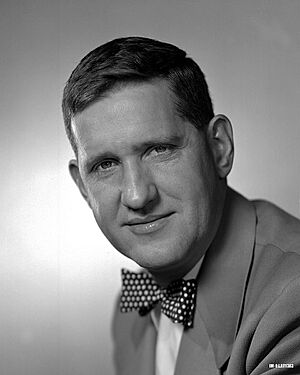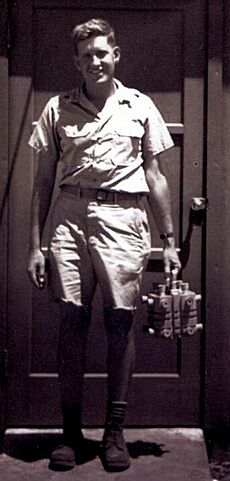Harold Agnew facts for kids
Quick facts for kids
Harold Agnew
|
|
|---|---|

Agnew in 1955
|
|
| Born |
Harold Melvin Agnew
March 28, 1921 Denver, Colorado, U.S.
|
| Died | September 29, 2013 (aged 92) Solana Beach, California, U.S.
|
| Education | University of Denver (BA) University of Chicago (MS, PhD) |
| Known for | Succeeded Norris Bradbury as director at Los Alamos |
| Awards | E. O. Lawrence Award (1966) Enrico Fermi Award (1978) |
| Scientific career | |
| Fields | Physics |
| Institutions | Los Alamos National Laboratory |
| Thesis | The Beta-spectra of Cesium-137, Yttrium-91, Chlorine-147, Ruthenium-106, Samarium-151, Phosphorus-32, and Thulium-170 (1949) |
| Doctoral advisor | Enrico Fermi |
Harold Melvin Agnew (March 28, 1921 – September 29, 2013) was an American physicist. He is famous for two main things: flying as a scientist during the Hiroshima bombing mission and later becoming the third director of the Los Alamos National Laboratory.
In 1942, he joined the Metallurgical Laboratory at the University of Chicago. There, he helped build Chicago Pile-1, which was the world's first nuclear reactor. In 1943, he moved to the Los Alamos Laboratory. He worked with a special machine called a Cockcroft–Walton generator.
After World War II ended, he went back to the University of Chicago. He finished his advanced studies under the famous scientist Enrico Fermi. Agnew returned to Los Alamos in 1949. He worked on the Castle Bravo nuclear test in 1954.
He became the head of the Weapon Nuclear Engineering Division in 1964. Agnew also served as a Democratic New Mexico State Senator from 1955 to 1961. From 1961 to 1964, he was a Scientific Adviser to NATO.
He was the director of the Los Alamos National Laboratory from 1970 to 1979. After that, he became the President and CEO of General Atomics. Harold Agnew passed away at his home in Solana Beach, California, on September 29, 2013.
Contents
Early Life and Education
Harold Melvin Agnew was born in Denver, Colorado, on March 28, 1921. He was the only child of parents who worked as stonecutters. He went to South Denver High School. Later, he studied chemistry at the University of Denver.
He was a good athlete and played for the university's softball team, which won a championship. He left the University of Denver in January 1942. However, he had enough credits to earn his Bachelor of Arts degree in June. He also received a scholarship to Yale University.
After the Japanese bombing of Pearl Harbor, the United States entered World War II. Agnew and his girlfriend, Beverly, wanted to join the United States Army Air Corps. Instead, Joyce C. Stearns, a physics professor, convinced Agnew to go with him to the University of Chicago. Stearns became a leader at the Metallurgical Laboratory there.
Agnew and Beverly got married in Denver on May 2, 1942. Then they moved to Chicago. Beverly worked as a secretary at the Metallurgical Laboratory. Harold and Beverly had two children, a daughter named Nancy and a son named John.
Working on the First Nuclear Reactor
At the Metallurgical Laboratory, Agnew worked with important scientists like Enrico Fermi and Walter Zinn. He helped build Chicago Pile-1, the world's first nuclear reactor. At first, Agnew worked with the equipment that measured radiation.
He received a high dose of radiation while calibrating Geiger counters. After that, he helped stack graphite bricks for the reactor. On December 2, 1942, he witnessed history. The reactor achieved the first controlled nuclear chain reaction.
In March 1943, Agnew and Beverly moved to the Los Alamos Laboratory. Agnew helped put together a Cockcroft–Walton generator, a type of particle accelerator. This machine was used for important experiments by other scientists. Beverly worked as a secretary for key leaders at Los Alamos, including Robert Oppenheimer.
When the experimental work slowed down, Agnew joined Project Alberta. This project focused on measuring the power of nuclear explosions. Agnew helped create a way to measure the blast's strength. They used special gauges dropped from planes that sent readings back to the aircraft.
In June 1945, he was given an Army uniform. He flew to Tinian in the Western Pacific. His first job was to install his measurement equipment in the B-29 aircraft The Great Artiste.
Hiroshima Mission
During the atomic bombing of Hiroshima on August 6, 1945, Agnew was a scientific observer. He flew in The Great Artiste, which followed the Enola Gay. Agnew later remembered, "After we dropped our gauges I remember we made a sharp turn to the right so that we would not get caught in the blast – but we still got badly shaken up by it."
He brought a movie camera and filmed the only existing movies of the Hiroshima event from the air. After the war, Agnew went back to the University of Chicago. He completed his advanced degrees under Enrico Fermi. He earned his Master of Science (MS) degree in 1948 and his Doctor of Philosophy (PhD) degree in 1949.
Los Alamos Leadership
After getting his PhD, Agnew returned to Los Alamos in 1949. He worked on developing nuclear weapons. In 1950, he joined the thermonuclear weapons project. He was the project engineer for the Castle Bravo nuclear test at Bikini Atoll in 1954. In 1964, he became the head of the Weapon Nuclear Engineering Division.
Public Service
Agnew served as a Democratic New Mexico State Senator from 1955 to 1961. He was the first state senator elected from Los Alamos County. Senators were not paid much, so he could continue working at Los Alamos. He took time off without pay to attend legislative sessions.
From 1961 to 1964, he was a Scientific Adviser to the NATO Supreme Allied Commander Europe (SACEUR). He also held several part-time advisory roles with the military over the years.
Director of Los Alamos
Agnew became the director of the Los Alamos National Laboratory in 1970. At that time, the laboratory had 7,000 employees. He took over when many original scientists were retiring. Under his leadership, Los Alamos developed new programs for underground nuclear tests.
The laboratory also completed its Meson Physics Facility. It acquired the first Cray supercomputer. Los Alamos also trained the first group of International Atomic Energy Agency inspectors.
Agnew helped Los Alamos get the job of developing important nuclear warheads. These included the W76, used by Trident I and Trident II missiles, and the W78, used by Minuteman III missiles. He was proud of the work that made nuclear weapons safer to handle.
Later Life and Legacy
In 1979, Agnew left Los Alamos. He became the President and Chief Executive Officer of General Atomics. He held this position until 1985. He explained that he resigned due to disagreements with university policies and funding issues.
Agnew led the General Advisory Committee of the Arms Control and Disarmament Agency from 1974 to 1978. He also served as a White House science advisor from 1982 to 1989. He was a member of NASA's Aerospace Safety Advisory Panel for many years.
He became a professor at the University of California, San Diego in 1988. He received the E.O. Lawrence Award in 1966. In 1978, he received the Enrico Fermi Award. He was also one of the first to receive the Los Alamos National Laboratory Medal.
Agnew believed that new U.S. nuclear weapon designs needed testing to be certified. He also thought that keeping the existing weapons reliable might be hard without testing. In a 1999 letter, he said that publicly available information about nuclear weapons could be as useful to other nations as secret data.
Beverly, his wife, passed away on October 11, 2011. Harold Agnew was diagnosed with chronic lymphocytic leukemia. He died at his home in Solana Beach, California, on September 29, 2013, while watching football. He was survived by his daughter Nancy and son John. His ashes were buried with Beverly's in Los Alamos.
In a 2005 interview, Agnew stated, "About three-quarters of the U.S. nuclear arsenal was designed under my tutelage at Los Alamos. That is my legacy."
Images for kids






